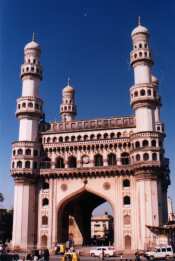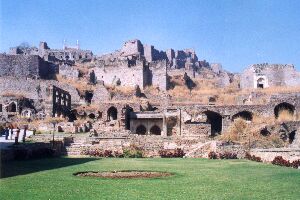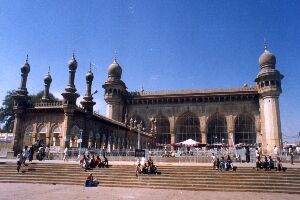
|

ABOUT HYDERABAD
Here's a collection of cool photos and articles about Hyderabad.
Some pictures and intresting places of Hyderabad my birth place..

CHARMINAR
Any tourist who steps into this 400-year-old city eagerly awaits a glance of this monument, which is to Hyderabad what the Statue of Liberty is to the USA and the Eiffel Tower is to Paris. Built in 1591-92 by the Qutb Shahi king Mohammad Quli Qutb Shah, this magnificent edifice that epitomises the pride of our city is a structure of char (four) huge minars (pillars). For the etymologists, the word minaret has originated from minar, rendered by the sweet sounding Urdu zabani.
Built to a height of 56.7meters (186 feet) and on a square base of 31.5 meters (100 feet), the Charminar is said to be a prototype of Tazia, a representation of the tomb of Imam Husain. It is also said that during the Mughal Governorship between the Qutb Shahi and the Asaf Jahi rule, lightning destroyed the South Western minaret which 'fell to pieces', but it was forthwith repaired at a cost of Rs 60,000! The whole structure was plastered in 1824 at a cost of Rs 100,000
|

GOLCONDA FORT
The Golconda Fort provides a majestic backdrop to Bhagyanagar, as Hyderabad was called once. Though the Kakatiyas, the Andhra rulers in the 12th Century, are credited with the original construction of the Fort, it was actually the Qutb Shahi kings that expanded the building. They used granite stones to reconstruct the Fort and fortify the massive structure with granite walls and barricades extending to nearly 7 kms in circumference.
It is said that the Hope Diamond, the Koh-i-Noor Diamond, the Orloff Diamond, etc. originated from this place
|

BIRLA TEMPLE
Birla Foundation over a period of time. The temple was constructed with white marbles from Rajasthan. A blend of North and South Indian temple architecture, the place dedicates the main temple in its precincts to Lord Venkateswara. Away from the hubbub of the city, the temple is located on top of the erstwhile Kala Pahad, the twin of Naubat Pahad. It overlooks the Tank Bund and makes an excellent spectacle when illuminated lavishly during the evenings
|

FALAKNUMA PALACE
The imperial building is the most famous palace in Hyderabad. Located on a hillock above 2000 ft high from the ground level, the palace looks awesome. You can't be caught unawares, as Jeremy Irons would put it.
The Falaknuma Palace stands about four kilometers south of the Charminar. Nawab Vikarul-Umra Bahadur, a baron of Paigah and the Prime Minister of Hyderabad, built it in 1883-84. However, the building yielded to many additions and alterations by its later inmates. The entire decor of the palace was changed under the orders of Nawab Mir Osman Ali Khan Bahadur, who succeeded Nizam VII.
|

GOLCONDA FORT
The Golconda Fort provides a majestic backdrop to Bhagyanagar, as Hyderabad was called once. Though the Kakatiyas, the Andhra rulers in the 12th Century, are credited with the original construction of the Fort, it was actually the Qutb Shahi kings that expanded the building. They used granite stones to reconstruct the Fort and fortify the massive structure with granite walls and barricades extending to nearly 7 kms in circumference.
It is said that the Hope Diamond, the Koh-i-Noor Diamond, the Orloff Diamond, etc. originated from this place
|

MECCA MASJID
Believed to be the largest mosque in the twin cities, Mecca Masjid claims to be able to accommodate about 10,000 people at a time during the prayer. Though Mohammad Quli Qutb Shah started the construction of the structure in 1617, it was the Mughal emperor Aurangzeb who actually completed it in 1694. Its huge columns and stately arches are built using single slabs of granite. It is said that a few bricks brought from Mecca were implanted in the walls of its main arch, hence the name. The tombs of the Asaf Jahi kings can be found near the mosque
|
|
|
